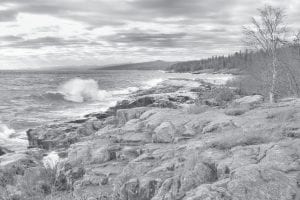A compilation of 86 studies has shown that many lakes worldwide are warming faster than the air temperatures around them. Lake Superior is warming faster than any of the other Great Lakes and two UMD professors have said if the warming trend continues, the lake will be largely ice free in the winter months in the coming decades.

A new study published in the Geophysical Research Letters (GRL) shows that the Great Lakes are some of the world’s fastest warming lakes, with Lake Superior warming faster than its counterparts.
The study cites the decline in ice coverage over the last 30-plus years as the major reason for the warming, and the study notes that the Great Lakes are warming faster than the air around them.
According to the research, Lake Superior is warming at a rate of 2.1 degrees Fahrenheit per decade. Meanwhile Lake Ontario is warming at .59 F per decade and Lake Erie .015 F per decade. The study separates northern Lake Michigan, which is warming .4 F per decade and southern Lake Michigan, which is warming 1.5 F per decade and northern Lake Huron, which is warming 1.5 F per decade and southern Lake Huron, which is warming at .79 F per decade.
Most of the data was collected from water and air temperatures measured from buoys in the lakes, and from satellite images. The study looked at research from 1985 to 2009, but also included a paper by two University of Minnesota Duluth (UMD) professors Jay A. Austin and Steven M. Colman, who gathered data from the Great Lakes from 1979 to 2006.
“The decline of this ice cover over the last several decades is contributing significantly to the rate of increase of summer water temperatures. Longer stratified seasons and warmer summer water temperatures are likely to have a significant impact on the ecology of the upper Great Lakes all trophic levels,” said the UMD professors in the paper.
Over the last 27 years summer stratification occurs 14 days earlier than it used to. In a dimictic lake like Superior, the water “flips” twice per year. Coming out of winter the water is colder on top than it is on the bottom but the surface temperature changes when the water column reaches a uniform temperature of 39 F (4 C), leading to the water on top to warm in the spring sun while it gets colder on the bottom. This stratification reverses late fall after the top water has warmed from the summer sun.
Warming waters can have a negative effect on the Great Lakes plant, fish, and animal life, and possibly speed up the development and growth of algae and invasive species.
“At the current rate of decline of ice cover, Lake Superior will be icefree in a typical winter in about two decades,” wrote the UMD professors in 2006. If proven right, that would leave 20 years of declining ice on the big lake before it is all gone.


Loading Comments